While relegation is a very hard sentence for most clubs, it offers an opportunity for change in an otherwise very fast-paced environment.
C.D. Santa Clara were in deep trouble when the club finished their 2022/23 campaign with three manager sackings and only 22 points from 34 games.
As with most relegated clubs, many players went on to find new opportunities in the top flight, meaning that C.D Santa Clara had to build a new team.
They did so by hiring Vasco Matos, a new manager who had been an assistant coach at Casa Pia for the previous three campaigns.
It was a change that would shape the club’s near future.
In just the first season after relegation, Santa Clara managed to become Champions of Liga Portugal 2 and got promoted back to the first division of Portuguese football.
Their biggest strength is their defence.
Matos‘ men only conceded 19 goals in 34 matches, which was 10 goals fewer than the second-best defence in the league conceded that season.
After promotion, most experts and even the club predicted another tough season.
With not much money to spend on reinforcements, Santa Clara were forecasted to face another relegation battle.
After six games, the team is in fourth place, however, only trailing Sporting CP, Porto, and Benfica in Liga Portugal so far.
In this tactical analysis and team analysis, we will examine why Santa Clara are having so much success under Vasco Matos, what tactics they are using, and what to expect from the club moving forward this season.
Vasco Matos Preferred Formation: 4-2-3-1 Press & A Deep Block Work Wonders
What’s interesting about Vasco Matos’ Santa Clara is that they are pretty much playing football according to very basic principles, and we will take a look at what that means throughout this analysis.
As previously mentioned, Santa Clara got promoted because of their elite defence last season.
While it may look like that has changed at first glance this season, it has not.
Yes, Santa Clara has conceded eight goals in six games so far this season.
Six of those goals came in the two games against giants — Benfica and Porto — meaning Matos‘ men only conceded two goals in the other four games.
Even with the two games in which they conceded many goals, Santa Clara still rank above average in almost every defensive category.
Vasco Matos use two tactical measures to help his team achieve this stability: their press and their defending in a deep block.
The most basic principle Matos gives his men at hand is also one of the most basic principles in football: condense the space to minimise the effective playing space for the opposing team, which Santa Clara use in the press and while defending in more static situations.
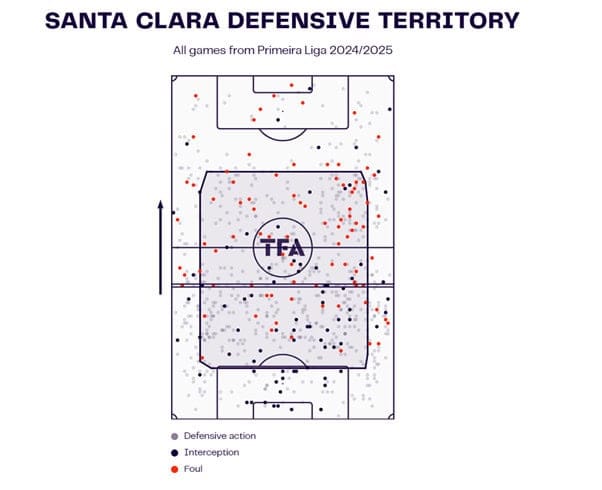
Here, we can see Santa Clara’s defensive territory this season so far.
We can see that the team takes many defensive actions in the final third, but with little success, and in its own defensive third, with great success.
It’s rather interesting that Santa Clara barely have any defensive actions in the midfield, which is where most smaller clubs usually start their press.
Another thing to pick out of this graphic is that Santa Clara is really good at minimizing the space for their opponents to play in.
This leads to a lot of pressure for opposing players, even if Santa Clara is falling back into a deep block.
Let’s take a look at the press of Santa Clara first.
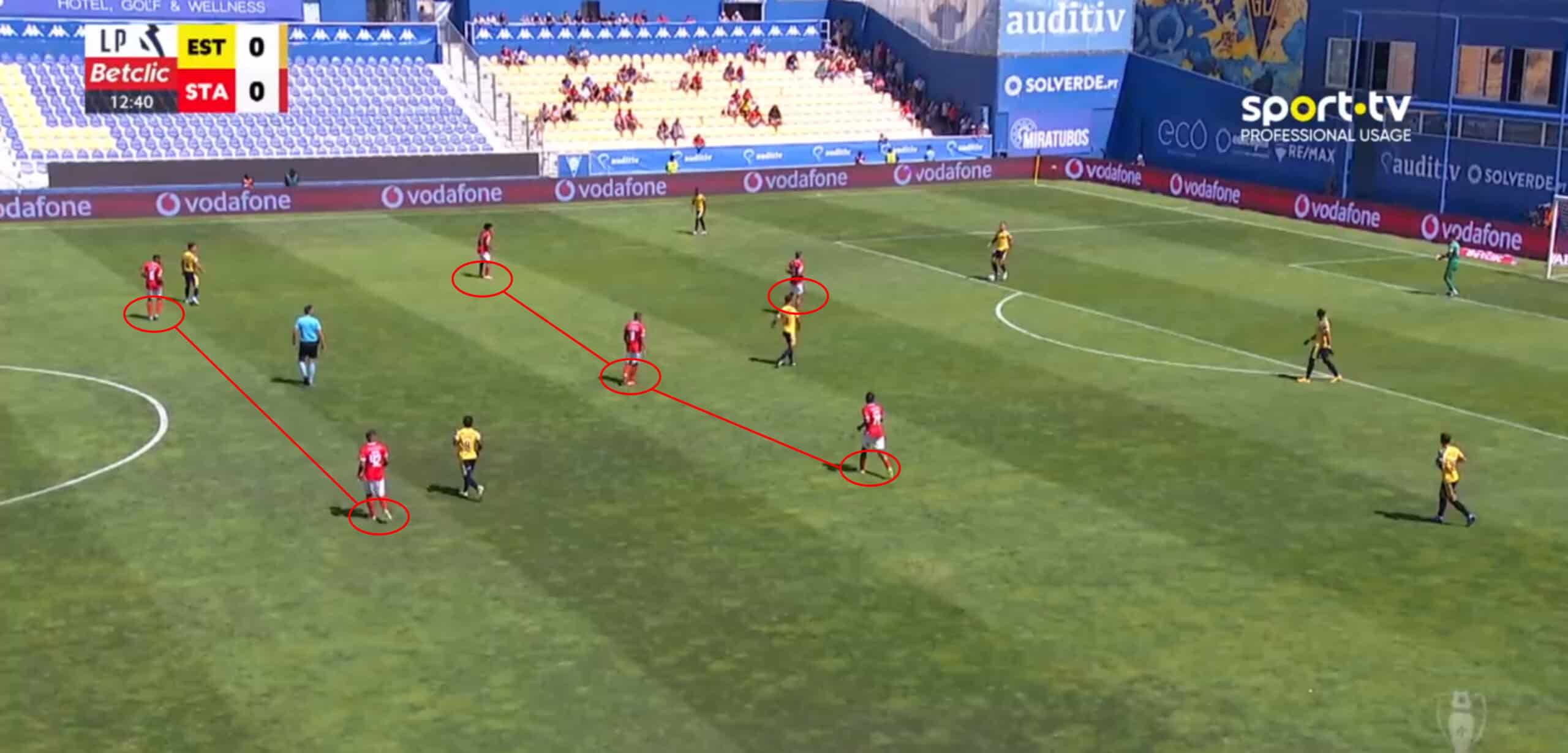
Here, we can see the press of Matos‘ men in the first game against Estoril.
While it might look like a rather normal press, it isn’t if we take a deeper look.
Santa Clara usually line up in a 3-4-3 but change things up in terms of shape during their press and only during their press.
As the picture above shows, Santa Clara change their shape into a 4-2-3-1 during these situations.
This happens most of the time when the right-back, Lucas Soares, leaves his position as a wing-back and pushes into midfield.
Sometimes, one of the centre-backs pushes up, and Soares moves back to form a back four.
This allows Santa Clara to overcome one of the bigger problems, a 3-4-3 formation, which usually provides several disadvantages in midfield.
With one of the defenders temporarily becoming an additional midfielder, the team can still control the centre of the pitch without having to give up any control in other areas of the field.
There are two more things that stand out about Vasco Matos‘ tactics in the press.
Firstly, the team’s shape is extremely narrow, allowing them to control the centre of the pitch.
The wingers are pushing in towards the middle of the field and cutting off passing options towards the midfield while still controlling the back-four in the build-up of Estoril, taking away any options to progress the ball through passing.
Secondly, the three midfielders are man-marked by Santa Clara, with the inverse right-back and one midfielder covering the two central midfielders and one midfielder pushing up to mark the holding midfielder.
While Santa Clara’s press does not allow them to win many high recoveries, it forces the opposing team to play many long balls, which the team is able to recover.
Santa Clara ranks first in aerial duels per 90 minutes and second in the percentage of won aerial duels in Liga Portugal, which allows them to interrupt opposing teams attacking plan early on and force their gameplan onto their opponents.
If the opposing team is playing through the first line of Santa Clara’s press, Vasco Matos has his team falling back into a deep block.
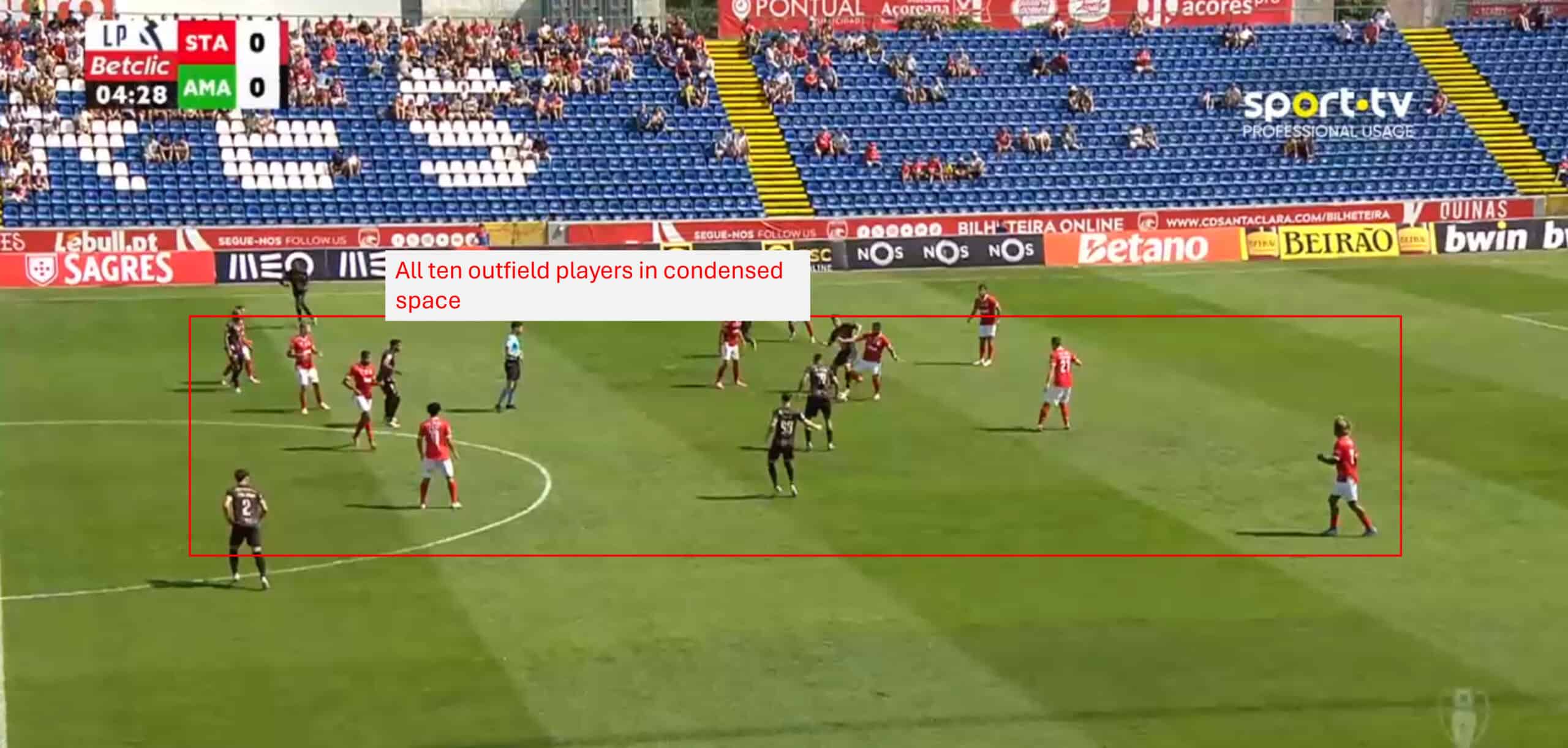
Here, we can see how Santa Clara, in red, line up against the ball in these situations.
With all ten outfield players in a very small area of the pitch, they are suffocating the centre of the pitch for the opposing teams, forcing them to play through the wings and crossing the ball into the box, where Santa Clara also has aerial dominance.
They are not dropping back into their own box; Matos’s last line is still pushing up the field, condensing the space even more.
The better teams, like Porto or Benfica, were still able to play through the midfield and then exploit the spaces on the wings and behind the defensive line.
However, against worse teams, Santa Clara’s defensive compactness allowed them to barely receive any goalscoring chances against themselves.
They ranked sixth in expected goals against in Liga Portugal through six games, even after facing two of the top teams during that timeframe.
Santa Clara has had the most tackles of any team in Liga Portugal through these six matches, which just shows that condensing the space and forcing the opponents into many tight situations works really well for them.
Just as last season, Santa Clara and Vasco Matos have a solid foundation against the ball that gives them stability and allows them to stay in pretty much every game they play by using basic principles to keep the spaces and distances small and forcing their style of play onto their opponents.
Wide Approach To Ball Progression
While Santa Clara’s obvious strength is their work against the ball, their offence is also really good so far this season.
With 10 goals scored in six games, Santa Clara currently have the fourth most goals in Liga Portugal so far this season, trailing only Sporting, Benfica and Porto.
This is not just an outlier.
Santa Clara also scored 8.31 expected goals during these six matches, ranking fourth in the league.
This shows that while the team’s foundation is its solid defence, it still finds ways to attack, creating a decent number of goalscoring chances.
At first, we will examine how Vasco Matos’ men progress the ball through their ranks, and then we will finally examine their play in the final third.
If we look at Santa Clara’s play, it’s obvious that they focus on ball progression through the outside of the pitch.
A 3-4-3 formation has a high focus on players out on the wing, with only two midfielders it would be very hard to play the ball through the midfield.
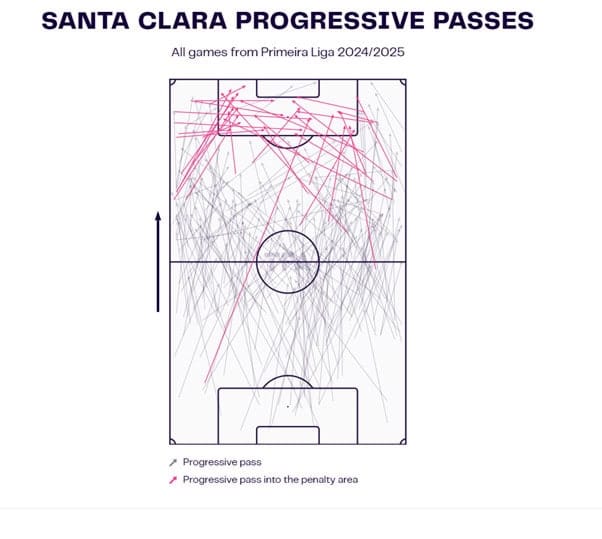
Here, we can see all the progressive passes that Santa Clara has played so far this season, and we can see multiple trends.
One, Santa Clara trigger play through their centre-backs, especially to the outside.
The two outside centre-backs’ progressive passes are received by the two wing-backs in the middle third near the outside line.
Two, Santa Clara always tries to play through their wingers and then play the ball into the box.
The majority of passes into the box come from the outside, with nearly none coming out of the attacking midfield position.
Third, Vasco Matos has his team not focusing on one side in the build-up, but when it comes to playing the ball into the box, Santa Clara has found way more success with their left-hand side.
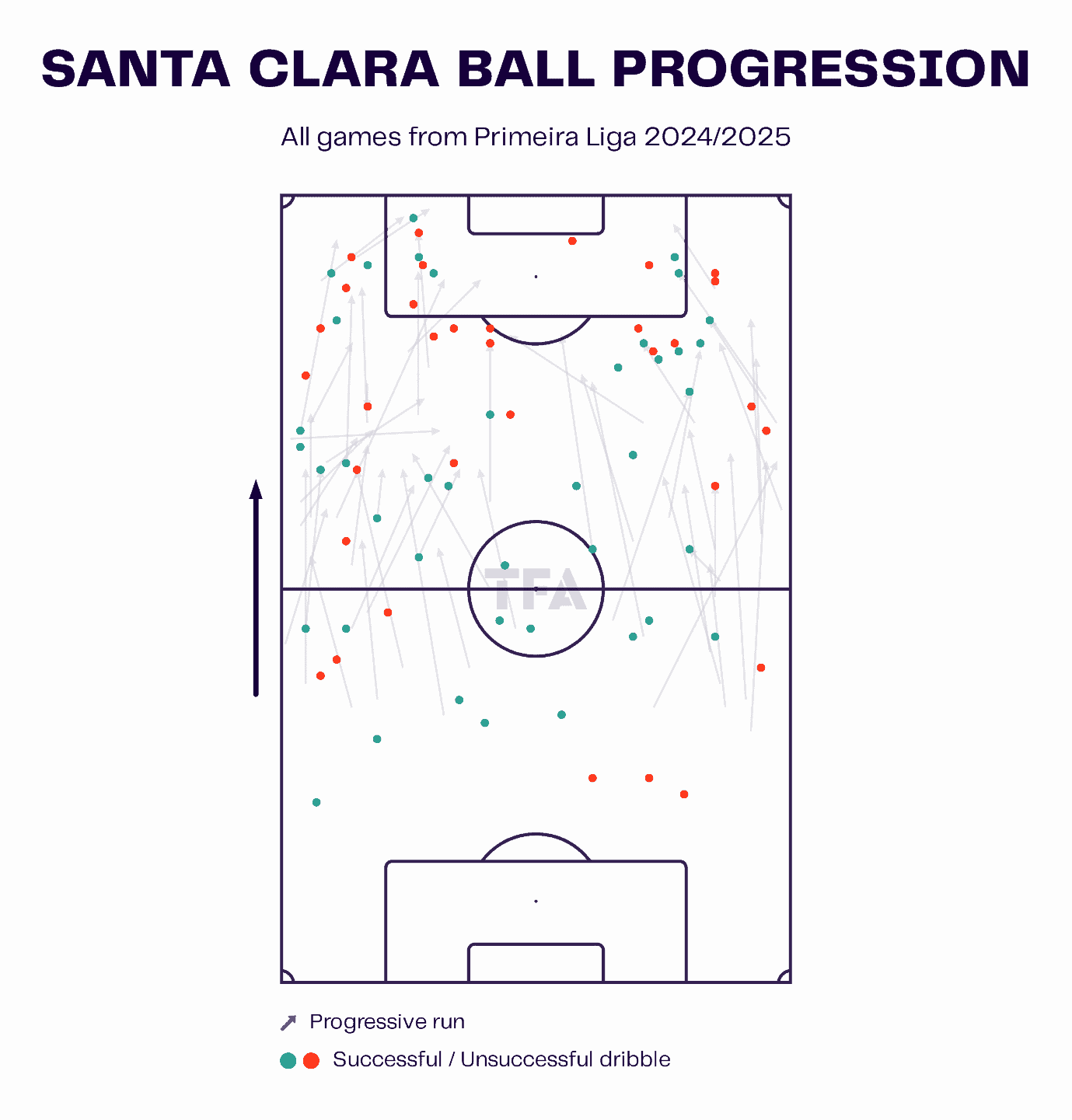
If we examine the progressive runs and dribbles, we can see similar patterns in Santa Clara’s play.
The majority of progressive runs come on the outside, with the wing-backs progressing the ball into the final third and the wingers pushing a bit more inwards, trying take-on there.
The midfield is being ignored, with only a couple of progressive actions coming from midfield positions.
This is interesting because, usually, the most efficient way to attack the opposing team’s goal is to go straight through the middle.
Still, Santa Clara proves they can effectively attack in different ways.
In a league that prioritises defending the middle of the pitch like it’s a religion, this approach may be the right one.
Let’s look at an example of Santa Clara with the ball.
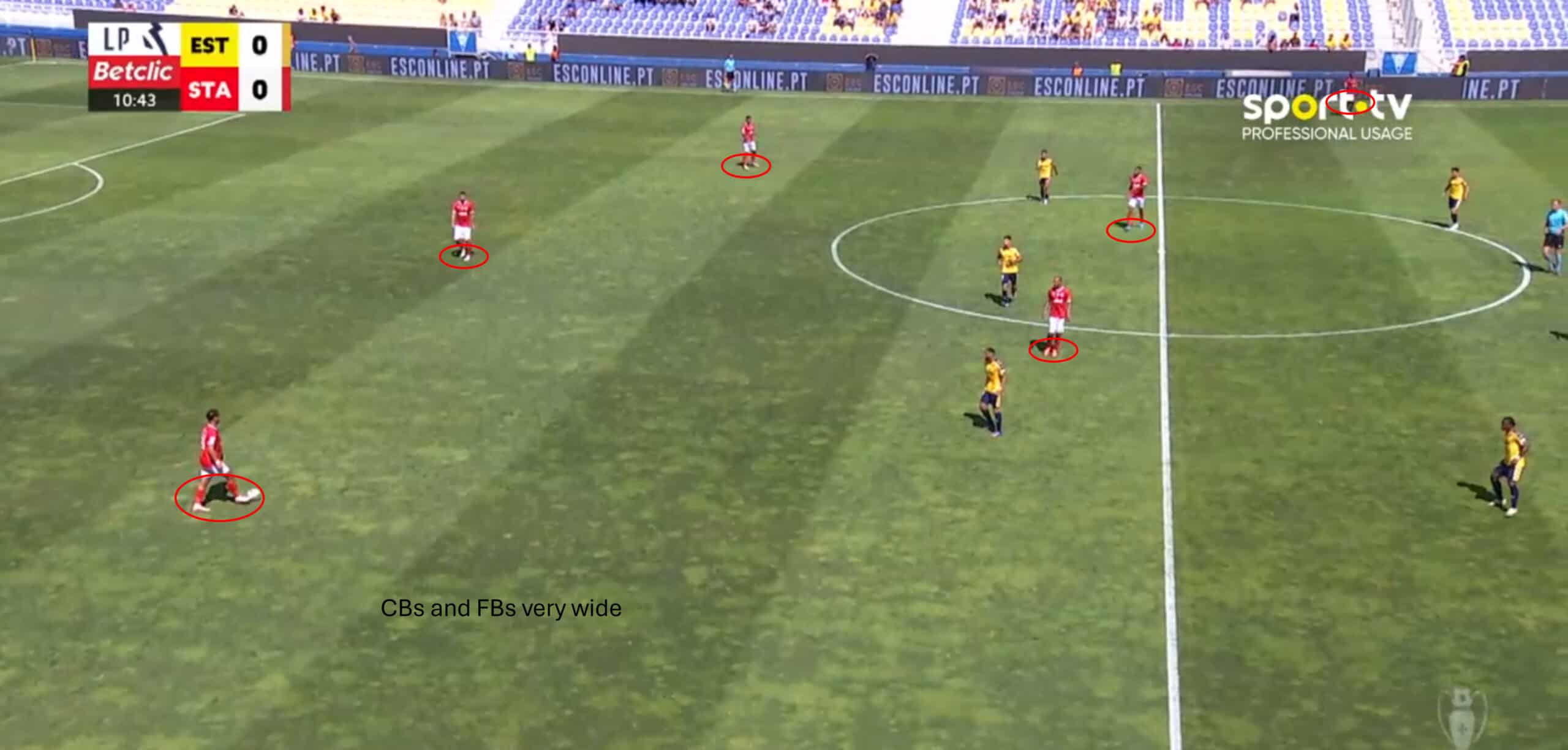
The opposing team is also in a very narrow shape, not playing an attacking press but rather defending the passing lanes into the midfield, but Matos’ men don’t really use these passes anyway.
The centre-backs are already in position, with the two outside centre-backs positioned wider.
The wing-backs are pushing up the field but not into the last line.
They are just a bit ahead of the midfielder and in a very wide position, so Santa Clara’s effective playing space covers the entire width of the pitch.
This allows the team to pretty much always have ball security in the back line, with five people plus two midfielders being able to be involved in the build-up, negating most of the press through pure numbers.
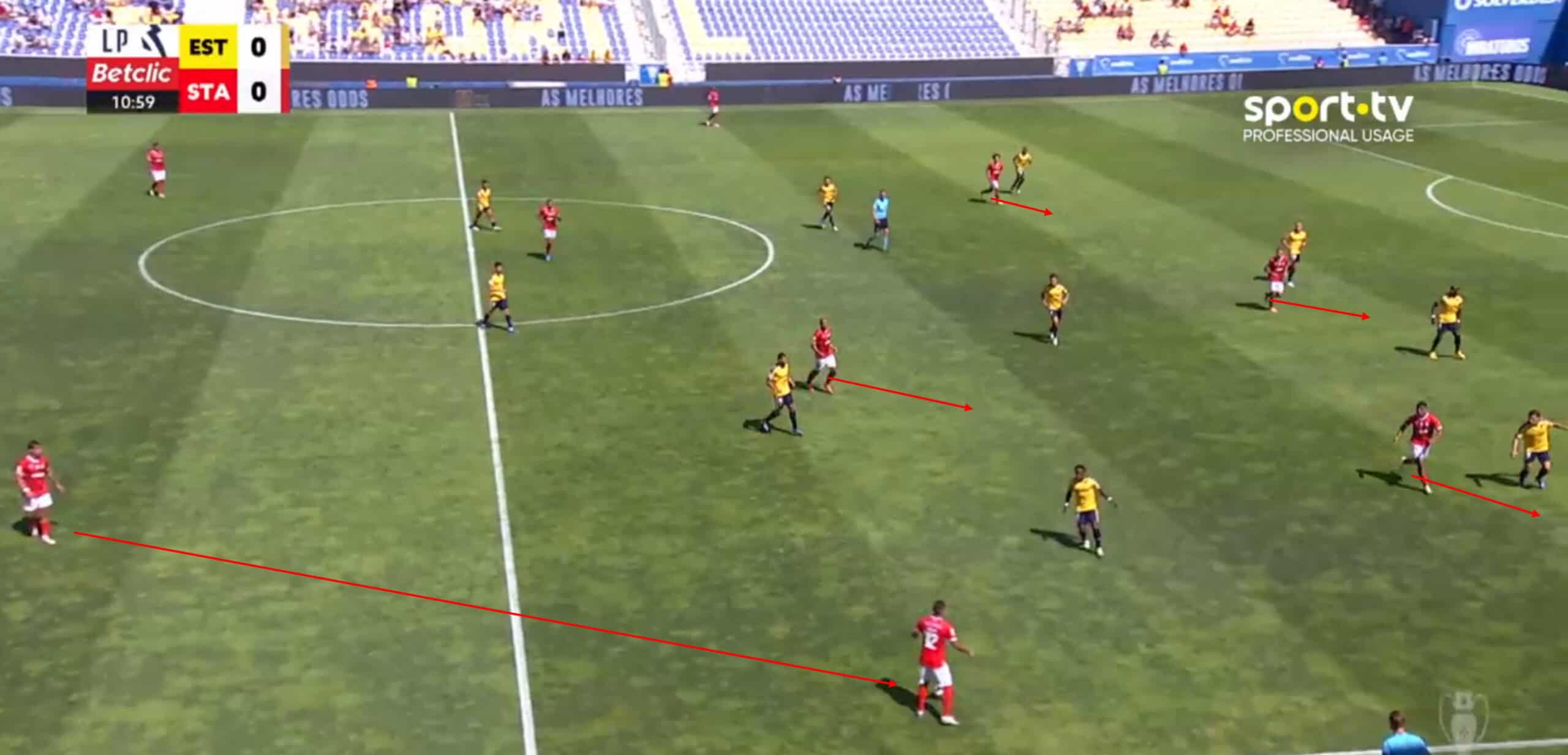
Vasco Matos has his men triggering play through an easy pass from his centre-backs towards the wings, as seen in the passing map we showcased earlier.
From there on, the wing-back can receive the ball in space with multiple options.
As every half-decent team does these days, Santa Clara then proceeds to overload one side of the pitch and tries to give the fullback options, especially to instantly find depth.
Santa Clara are not a team that wastes a lot of time after triggering play.
The wing-backs are either committing 100% to the play and trying to get their wingers or the deep run of one of their midfielders involved, or they are stopping the play and playing the ball back towards their centre-backs.
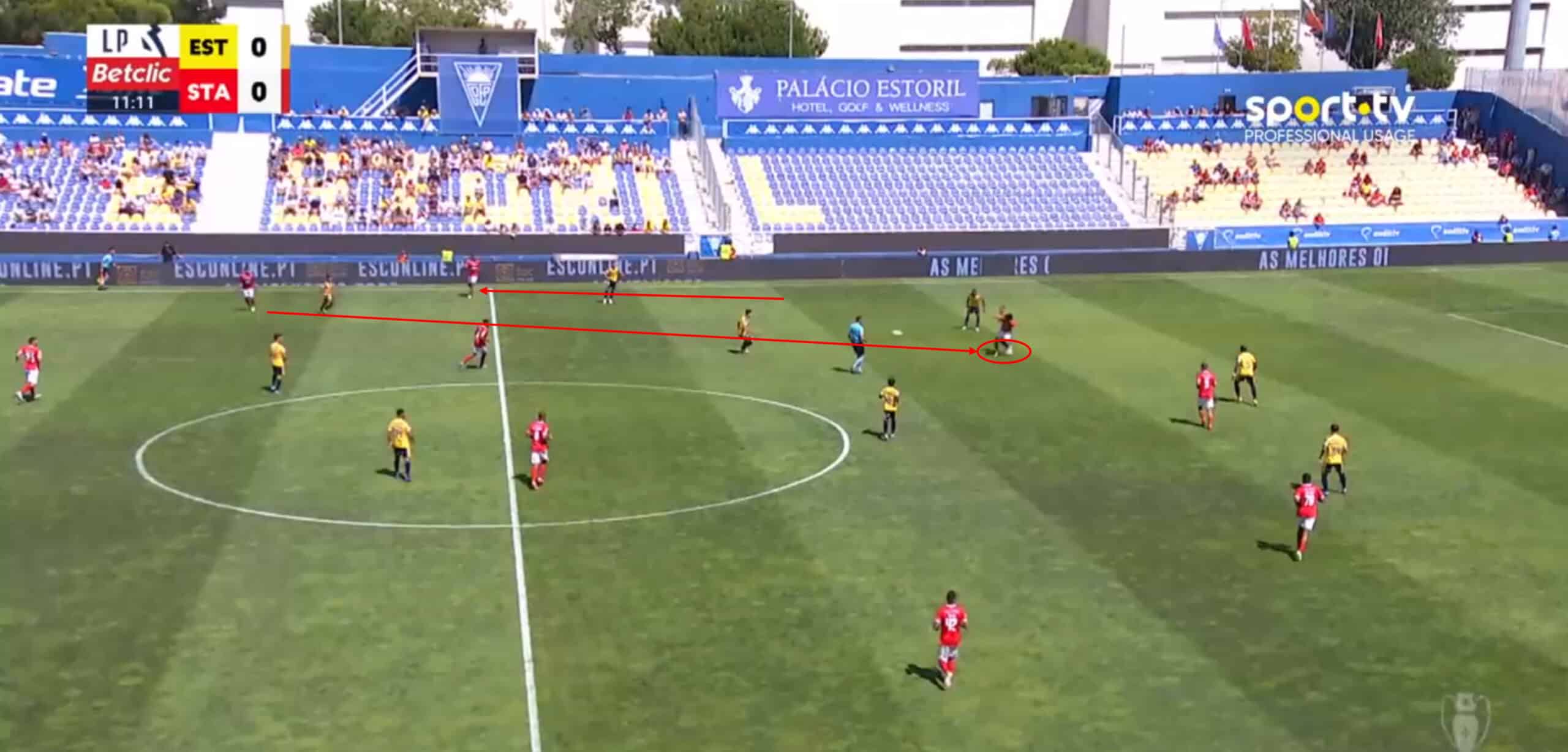
If they can not get their wing-backs involved, they sometimes even skip that step in the build-up.
In the picture above, the opposing full-back is man-marking Santa Clara’s left wing-back, which opens up a passing lane to the left winger.
The left centre-back instantly takes advantage of this to get the ball into their last line and into the final third.
Santa Clara progress the ball through these wide positions a lot and find a lot of success with it in possession as well as on the counter.
This allows them to get a lot of tempo into their attacks after winning the ball with their good defensive work.
Efficiency Is Key
However, what stands out about Santa Clara’s attack this season is something different.
While they created a decent amount of expected goals, Santa Clara ranks second to last in terms of shots per 90 minutes, which means they are one of the worst teams considering the offensive volume.
They are leading the league in non-penalty expected goals per shot, goals per shot and non-penalty-expected goals overperformance this season so far.
This just means that while Santa Clara is not creating a whole lot of goal-scoring chances per game, the looks that they are creating are highly likely to end in a goal, and they are finishing off their attacks well by staying calm in front of goal and converting their good opportunities so far this season.
Let’s take a look at how efficient they really are.
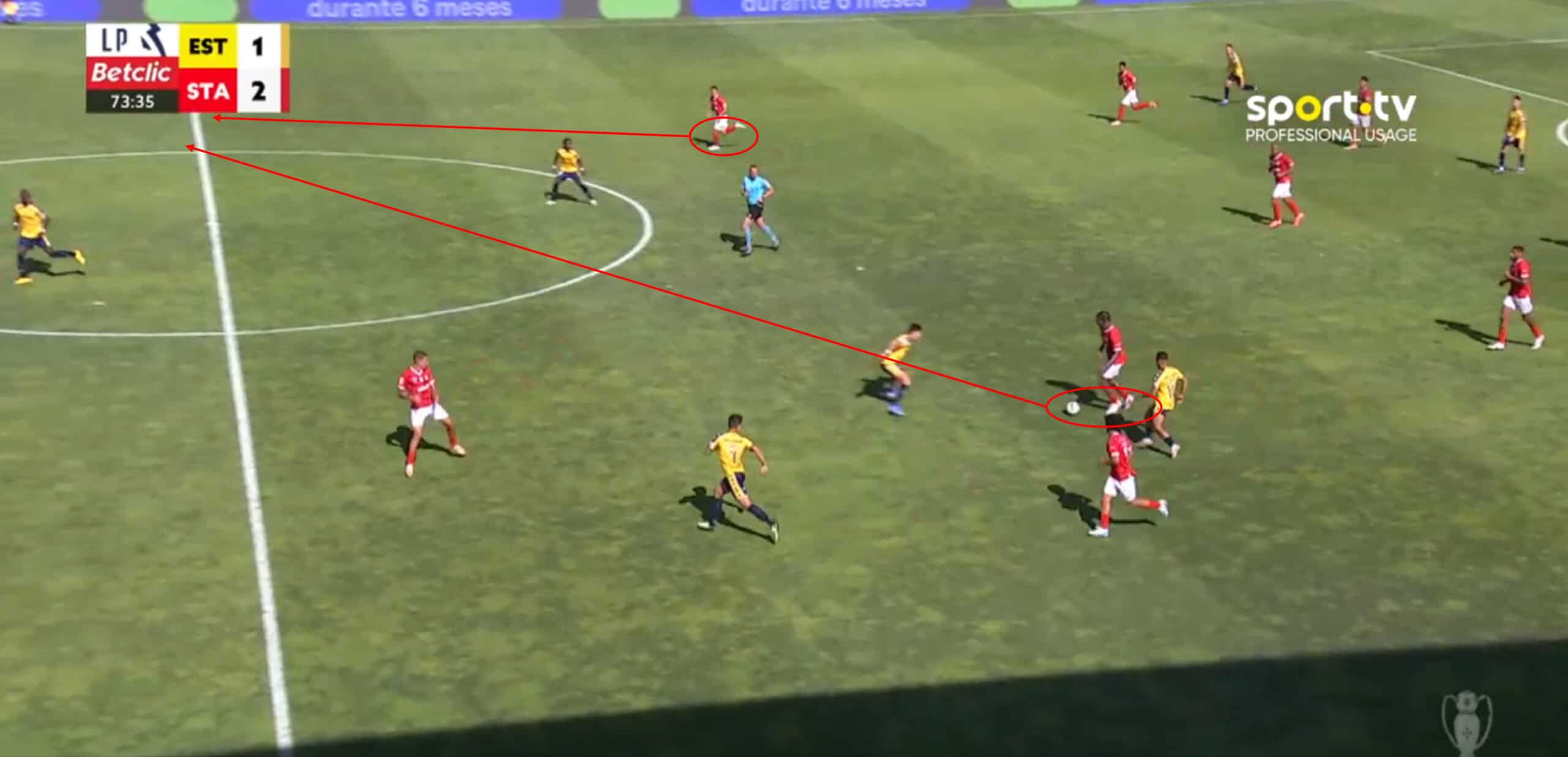
Here, we can see Santa Clara on the counter in the late stages of a game after just taking the lead.
Once again, they managed to win the ball back in their own third by defending well.
From then on, they do not waste any time.
They instantly look for depth and find it on the right-hand side of the field by playing a switch to the right winger.
This allows them to cover the entirety of the pitch with just two passes.
From there on, right-winger Ricardinho carries the ball into the final third on the right-hand side and plays a ball to his striker on the left side.
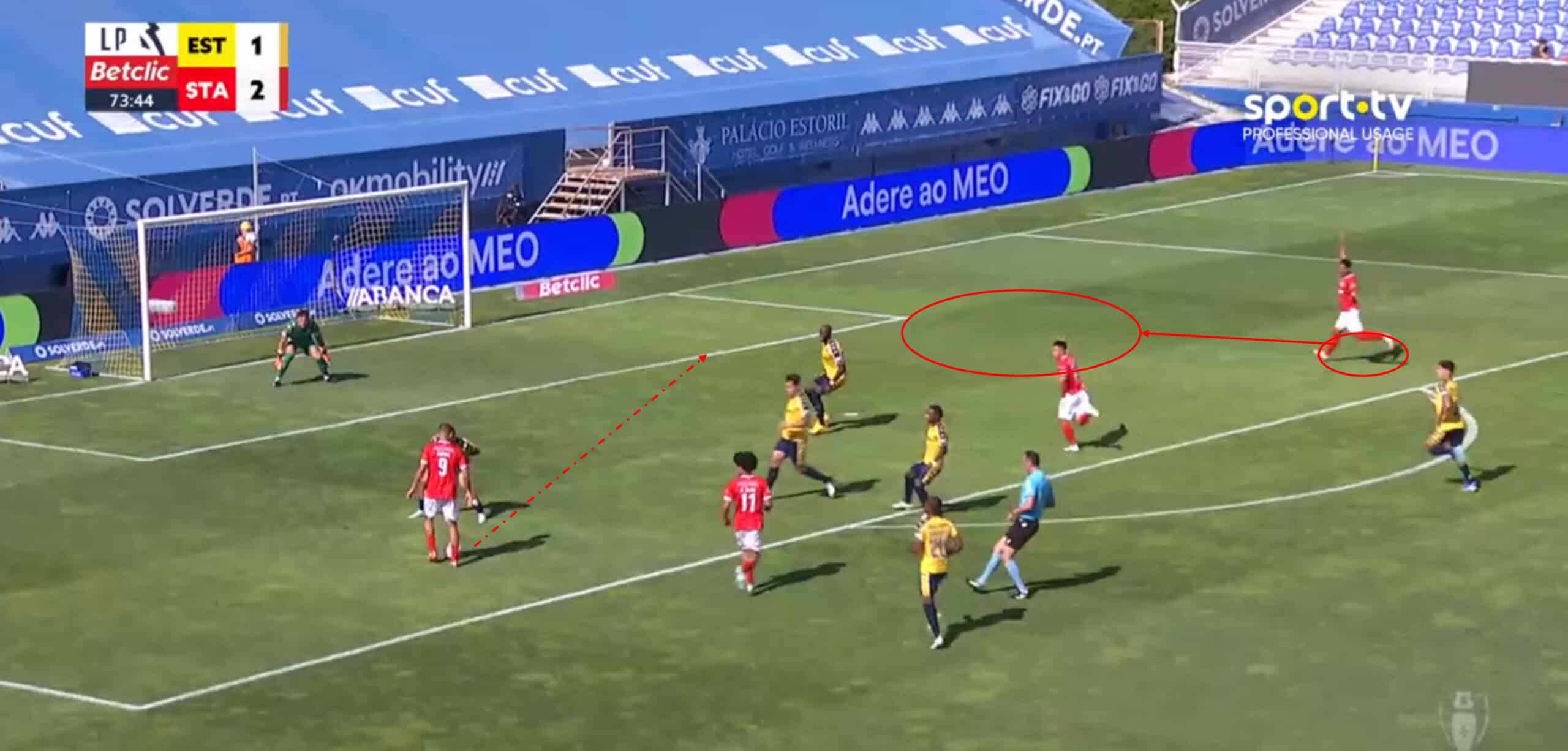
Santa Clara create a big chance. From there on, the ball-carrier keeps on moving into the box, where two other Santa Clara players are already moving in.
This allows the striker to play an easy pass towards the far post, where Ricardinho can finish all alone, scoring an easy goal and finishing off the game.
This pattern of play is found a lot in Matos’ tactics, with Santa Clara finding opportunities to cross on the left side of the field and making good runs into the box on the far post.
While it isn’t an overly complicated concept, it is still very efficient for Santa Clara, simply because their movement in and into the box is well orchestrated, always allowing them to have a target man for their crosses.
With a lot of pace down the wing, a team that always looks to find the depths of the pitch quickly, and many players in the box, Santa Clara have been the most efficient attack in Liga Portugal so far this season, and it does not seem like this is an unsustainable state for them throughout the year.
Conclusion
Even after coming off a really good season in the second division, Santa Clara was seen as a relegation candidate coming into this season in Liga Portugal.
Vasco Matos and his men have defied expectations so far this season with a very compact defensive approach and an efficient attacking style.
While their football might not be the most interesting or tactically advanced style of play in European football right now, Santa Clara still has a clear identity and is executing its basic principles flawlessly.
This allows it to maintain its defensive stability and attack down the wings with a lot of power.
While this might not be enough to beat the big teams like Porto or Benfica, they have won against every other midfield or bottom-tier team they have faced so far this season, getting a nice little cushion between themselves and the relegation zone.
While Santa Clara is not looking like a top team at the moment, the team is consistent and well-coached enough to avoid a relegation battle this season, which should be considered an immense success for the small club from the Azores.

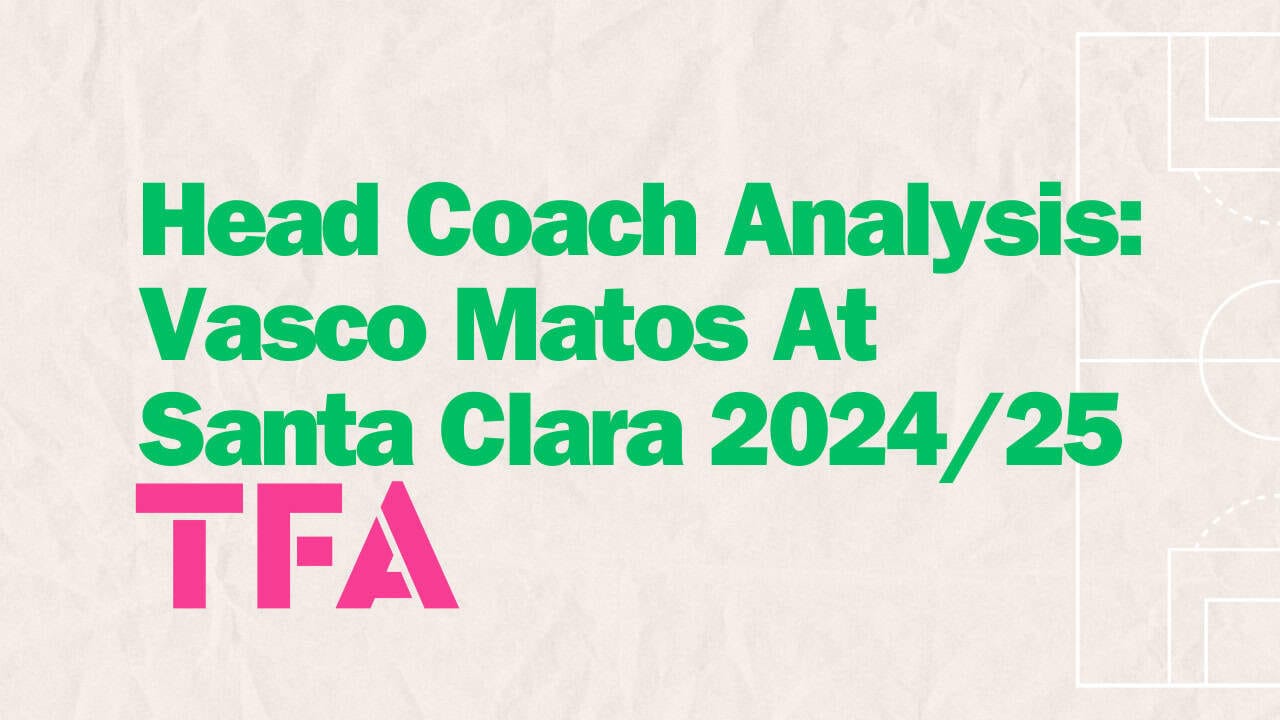




Comments